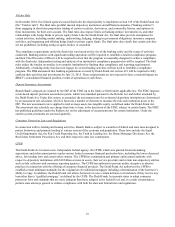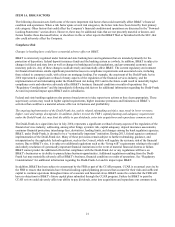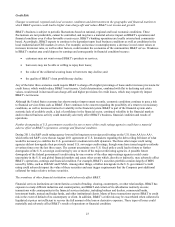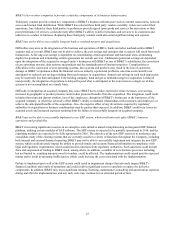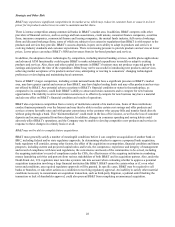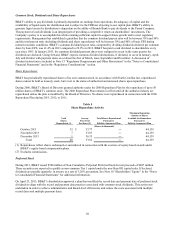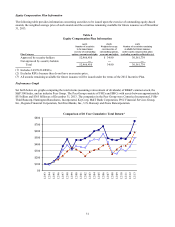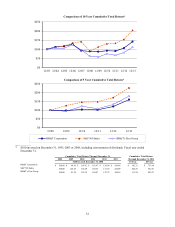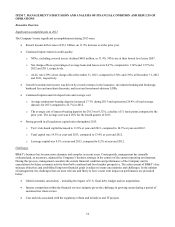BB&T 2013 Annual Report Download - page 25
Download and view the complete annual report
Please find page 25 of the 2013 BB&T annual report below. You can navigate through the pages in the report by either clicking on the pages listed below, or by using the keyword search tool below to find specific information within the annual report.
25
Changes in interest rates may have an adverse effect on BB&T’s profitability.
BB&T’s earnings and financial condition are largely dependent on net interest income, which is the difference between
interest earned from loans and investments and interest paid on deposits and borrowings. The narrowing of interest rate
spreads could adversely affect BB&T’s earnings and financial condition. BB&T cannot control or predict with certainty
changes in interest rates. Regional and local economic conditions, competitive pressures and the policies of regulatory
authorities, including monetary policies of the FRB, affect interest income and interest expense. As discussed in “Market
Risk Management – Interest Rate Market Risk (Other than Trading),” BB&T has ongoing policies and procedures designed
to manage the risks associated with changes in market interest rates. However, changes in interest rates still may have an
adverse effect on BB&T’s profitability. For example, rising interest rates could adversely affect BB&T’s mortgage banking
business because higher interest rates could cause customers to apply for fewer mortgages. Similarly, rising interest rates may
increase the cost of BB&T’s deposits, which are a primary source of funding. While BB&T actively manages against these
risks through hedging and other risk mitigation strategies, if BB&T’s assumptions regarding borrower behavior are wrong or
overall economic conditions are significantly different than anticipated, the Company’s risk mitigation techniques may be
insufficient.
Loss of deposits could increase the Company’s funding costs.
Deposits are a low cost and stable source of funding. BB&T competes with banks and other financial institutions for deposits.
Funding costs may increase because the Company may lose deposits and replace them with more expensive sources of
funding, clients may shift their deposits into higher cost products or the Company may need to raise its interest rates to avoid
losing deposits. Higher funding costs reduce the Company’s NIM, net interest income and net income.
Operational Risk
BB&T faces security risks, including “denial of service attacks,” “hacking” and “identity theft” that could result in the
disclosure of confidential information, adversely affect BB&T’s business or reputation and create significant legal and
financial exposure.
BB&T’s computer systems and network infrastructure are subject to security risks and could be susceptible to cyber-attacks,
such as denial of service attacks, hacking, terrorist activities or identity theft. Financial services institutions and companies
engaged in data processing have reported breaches in the security of their websites or other systems, some of which have
involved sophisticated and targeted attacks intended to obtain unauthorized access to confidential information, destroy data,
disable or degrade service, or sabotage systems, often through the introduction of computer viruses or malware, cyber-attacks
and other means. Denial of service attacks have been launched against a number of large financial services institutions,
including BB&T. None of these events resulted in a breach of BB&T’s client data or account information; however, the
performance of BB&T’s website, www.bbt.com, was adversely affected, and in some instances customers were prevented
from accessing BB&T’s website. We expect to be subject to similar attacks in the future. While events to date primarily
resulted in inconvenience, future cyber-attacks could be more disruptive and damaging. Hacking and identity theft risks, in
particular, could cause serious reputational harm. Cyber threats are rapidly evolving and BB&T may not be able to anticipate
or prevent all such attacks. BB&T may incur increasing costs in an effort to minimize these risks and could be held liable for
any security breach or loss.
Despite efforts to ensure the integrity of its systems, BB&T will not be able to anticipate all security breaches of these types,
and BB&T may not be able to implement effective preventive measures against such security breaches. The techniques used
by cyber criminals change frequently, may not be recognized until launched and can originate from a wide variety of sources,
including outside groups such as external service providers, organized crime affiliates, terrorist organizations or hostile
foreign governments. Those parties may also attempt to fraudulently induce employees, customers or other users of BB&T’s
systems to disclose sensitive information in order to gain access to its data or that of its clients. These risks may increase in
the future as the Company continues to increase its mobile-payment and other internet-based product offerings and expands
its internal usage of web-based products and applications.
A successful penetration or circumvention of system security could cause serious negative consequences to BB&T, including
significant disruption of operations, misappropriation of confidential information of BB&T or that of its customers, or
damage to computers or systems of the Company or those of its customers and counterparties. A successful security breach
could result in violations of applicable privacy and other laws, financial loss to BB&T or to its customers, loss of confidence
in BB&T’s security measures, significant litigation exposure, and harm to BB&T’s reputation, all of which could have a
material adverse effect on the Company.



